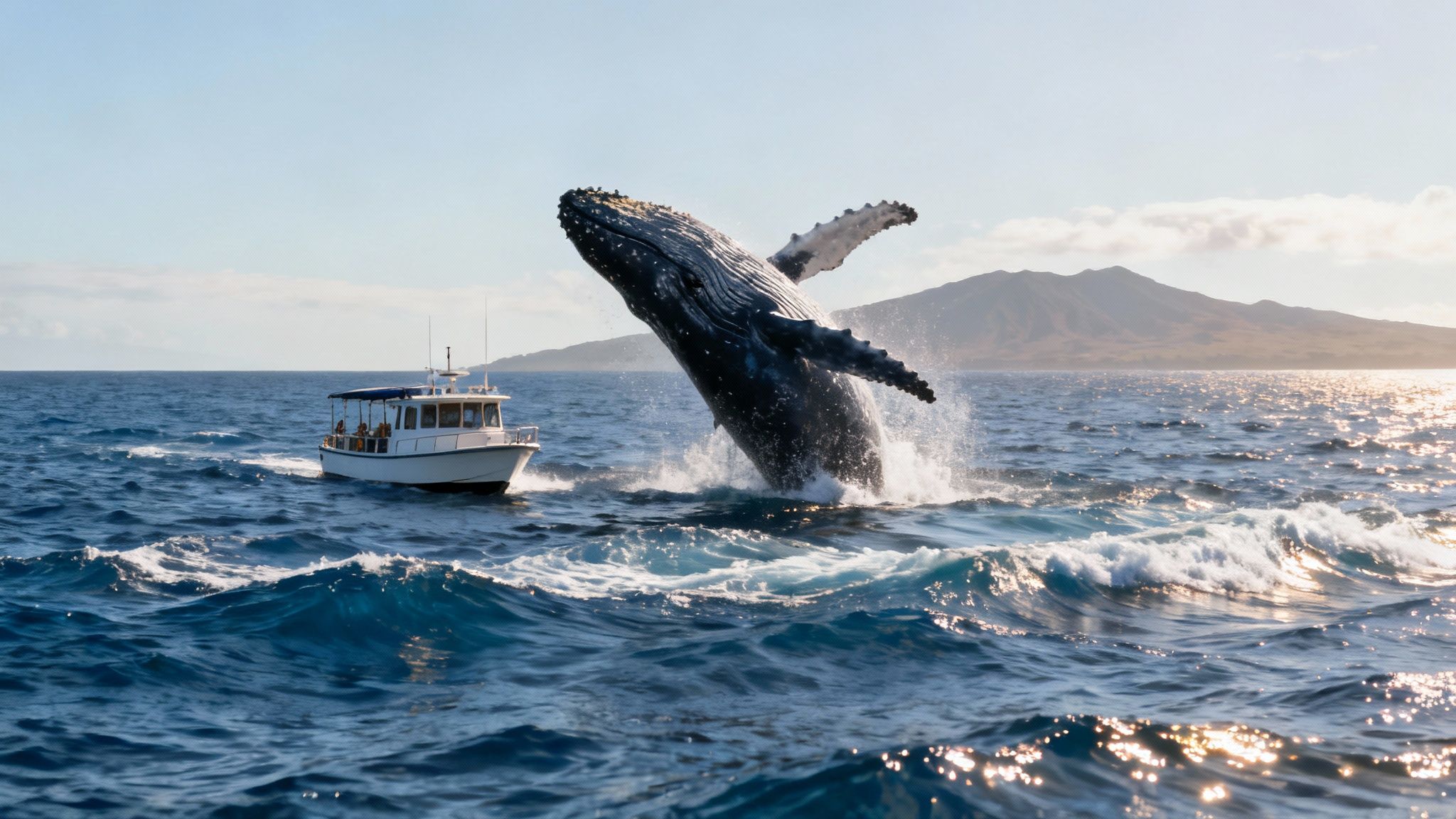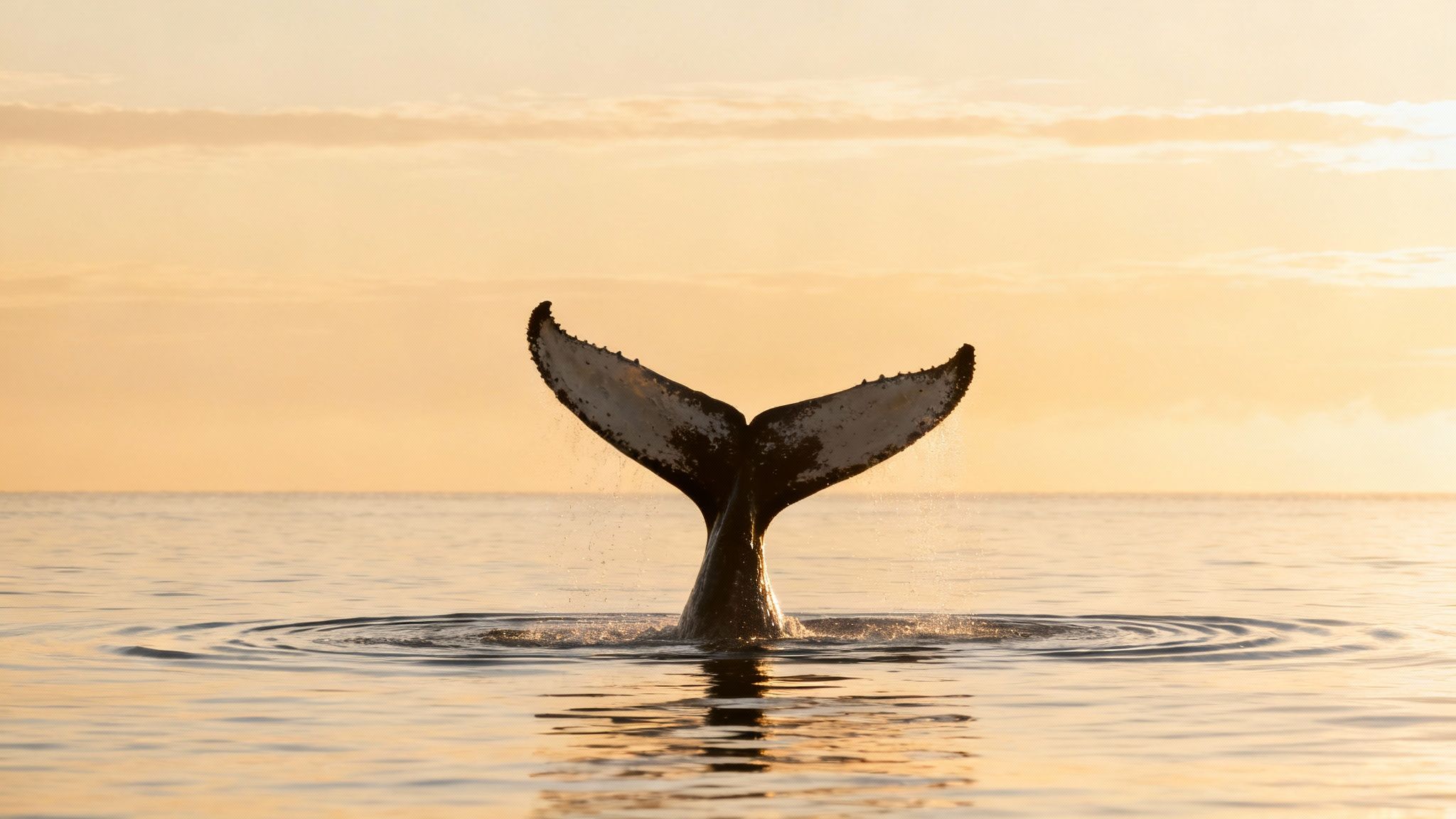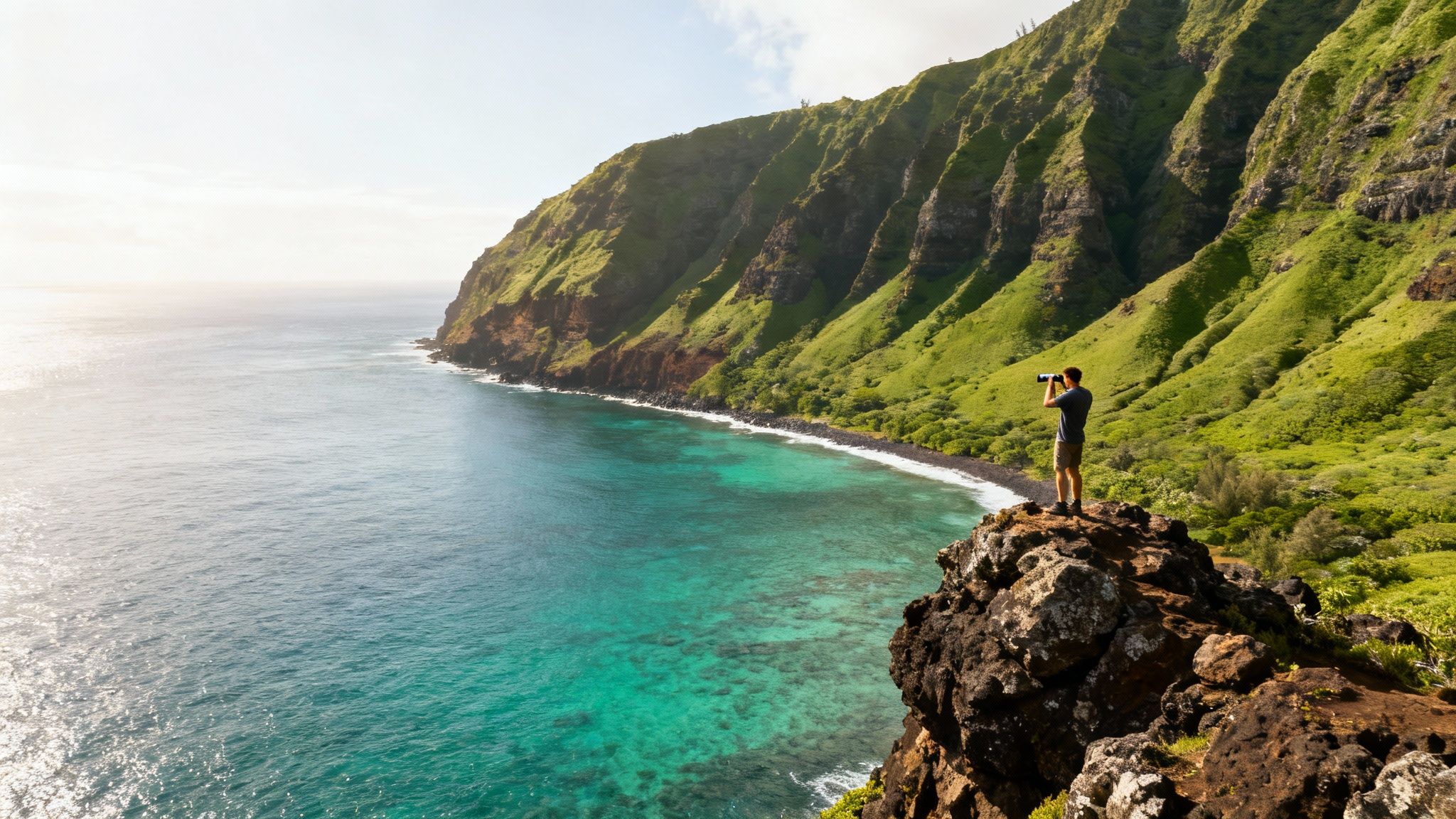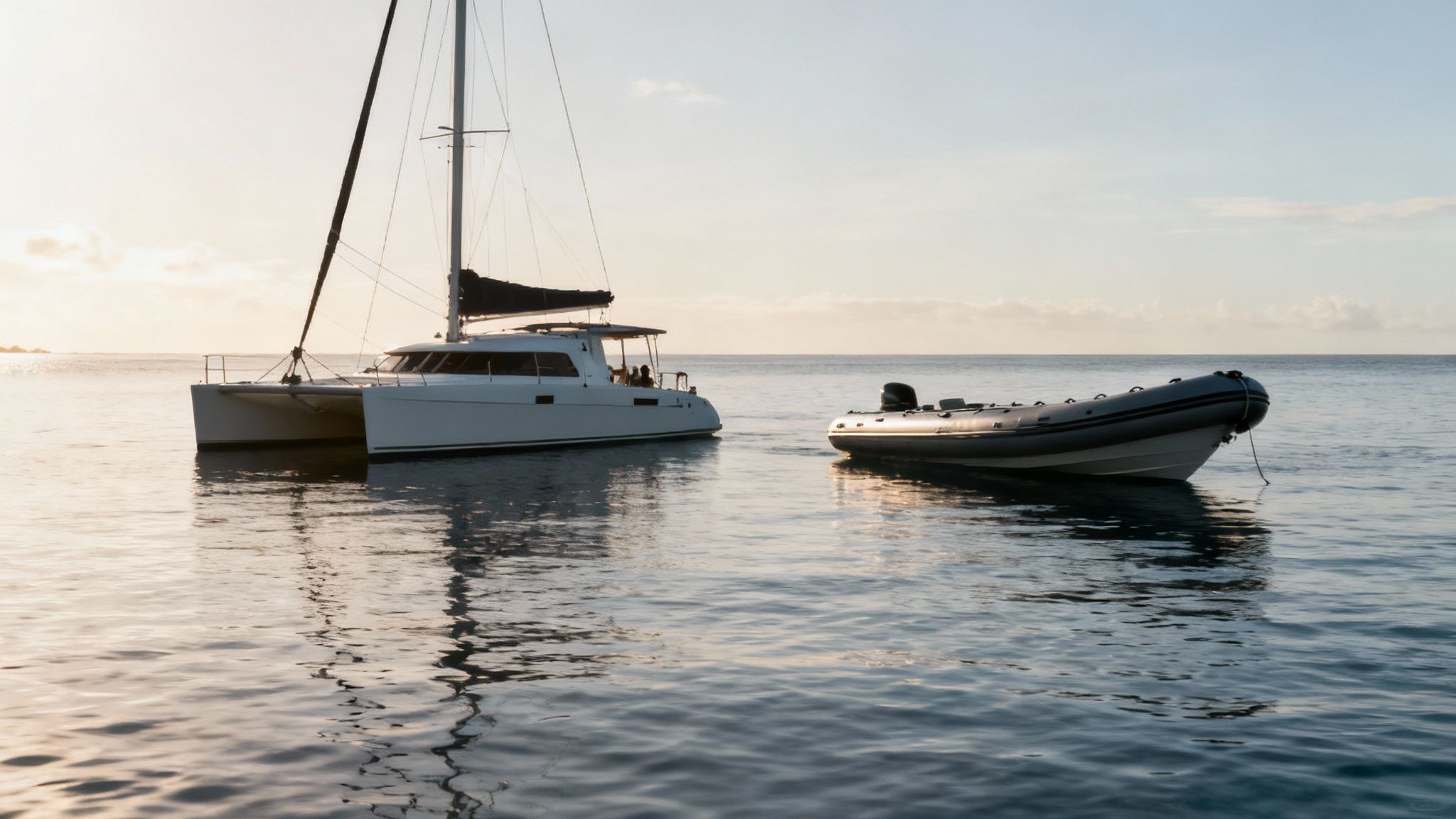Whale Watching Big Island: Your Ultimate Guide

There's nothing quite like the sight of a 40-ton humpback whale launching its entire body out of the Pacific—it's a moment of pure magic, and it's what makes whale watching on the Big Island so special. Every year, Hawaii's warm, protected waters become the number one destination for thousands of these incredible animals. Honestly, it's one of the best places on Earth to see them.
Your Ultimate Guide to Big Island Whale Watching
This is where we'll break down everything you need for a once-in-a-lifetime adventure. The annual migration brings these gentle giants to the Big Island to breed, give birth, and nurse their calves, creating a natural spectacle that’s just breathtaking. As the top-rated and most-reviewed snorkel company in Hawaii, we at Kona Snorkel Trips live for creating these kinds of unforgettable marine adventures.
We're going to cover all the bases so you can make your trip a huge success. From figuring out the best season for sightings to finding the prime viewing spots, this guide will get you ready for an amazing day on the water.

What to Expect From This Guide
Planning your whale watching trip should be fun, not a headache. We've laid out all the essential info into easy-to-read sections to help you get prepped.
Here’s a sneak peek at what you'll find inside:
- The 'Why' Behind the Migration: We'll get into why thousands of humpback whales make the long journey to Hawaii every single winter.
- The Best Viewing Spots: You'll learn the top locations on the Big Island for frequent sightings, whether you're on a boat or watching from shore.
- Picking the Right Tour: We’ll give you some insider tips on how to choose a whale watching tour that perfectly fits your vibe and budget.
- Your Day-Of Checklist: Find out exactly what to pack and how to prepare for a comfortable and totally memorable day out on the ocean.
This isn't just about sightseeing; it's a chance to connect with one of the planet's most majestic creatures right in their own element. When you understand their behaviors and why they make this incredible journey, it makes the whole experience that much more profound.
Get ready to see it all—awe-inspiring breaches, powerful tail slaps, and the iconic spouts of humpbacks set against the incredible backdrop of the Hawaiian coastline. Your adventure starts right now.
Understanding The Humpback Whale Migration
That incredible sight of a humpback whale breaching off the Big Island coast isn't just a happy accident. It's the grand finale of one of nature's most epic road trips. Every single winter, these gentle giants travel thousands of miles from the cold, food-rich waters of Alaska down to the warm, protected seas around Hawaii. This massive journey is all about the most fundamental instinct: creating and protecting new life.
Hawaii's calm, shallow waters are the perfect nursery. This isn't a vacation for the whales; it's a critical part of their life cycle. They come here specifically to mate, give birth, and nurse their newborn calves in a safe environment, far from the harsh conditions and predators of the northern Pacific.

Hawaii's Official Whale Season
The official season for whale watching on the Big Island runs from November through April, but what you'll see changes quite a bit from month to month. The first scouts start showing up in late November, and their numbers just keep building as winter sets in.
But if you want the real action, the absolute peak is from January through March. During these months, the ocean is practically boiling with activity. Thousands of whales are in the area, which means sightings are not only more frequent but way more spectacular. This is your best shot to see the full range of behaviors.
Thanks to amazing conservation efforts since the 1960s, the Pacific humpback whale population has bounced back to about 26,000 individuals. This incredible recovery is what supports the amazing whale watching we get to experience today.
To help you nail down the perfect time for your trip, here's a quick look at what you can expect month by month.
Big Island Whale Watching Season At-a-Glance
| Month | Whale Activity Level | Typical Behaviors Observed |
|---|---|---|
| November | Low | First arrivals spotted, often solo whales or small pods. Primarily travel behaviors. |
| December | Moderate | Numbers increasing. Mating competition begins with some surface activity. |
| January | High | Peak season begins. Lots of competitive pods, breaching, and tail slapping. |
| February | Peak | Highest concentration of whales. Frequent sightings of all behaviors. Calves are visible. |
| March | High | Still peak season, but mothers with newborn calves are now the main event. Very active. |
| April | Moderate | Whales begin their migration back north. Sightings of mother-calf pairs heading out. |
| May | Low | Last of the stragglers seen. Season is effectively over. |
As you can see, planning for January, February, or March gives you the best odds for a truly unforgettable experience on the water.
Decoding Whale Behaviors
Watching these massive animals is one thing, but it becomes a totally different experience when you know what you're looking at. Understanding their actions transforms you from a spectator into someone who's actually connecting with what's happening out there. For a deeper dive, check out our complete guide to the Big Island's whale season.
Here are a few of the most common and jaw-dropping behaviors you might get to see:
- Breach: This is the big one—the move everyone hopes to witness. A whale launches its entire massive body out of the water, crashing back down in a thunderous splash. Scientists think it could be a way to communicate, shake off pesky parasites, or maybe, they're just having fun.
- Tail Slap (Lobtailing): You'll hear this one before you see it. A whale lifts its giant tail flukes high and smacks them down on the water with incredible force. It's often used as a warning signal or a way to talk to other whales from a distance.
- Pectoral Fin Slap: A whale will roll onto its side and just start smacking its long pectoral fin against the water over and over again. It creates a really distinct sound and is another go-to method of communication.
- Spyhop: This one is just cool. The whale pops its head straight up out of the water, sometimes high enough to get its eyes above the surface. It's basically checking you out, getting a good look at the boat and its surroundings.
- Blow: This is the classic sign that a whale is nearby. When a humpback comes up for air, it lets out a powerful exhale of air and water vapor that can shoot 15 feet into the sky. When you're out on the boat, your best bet is to constantly scan the horizon for these misty spouts.
Each splash and surface has a purpose, telling a story about communication, courtship, or parenting. Witnessing these behaviors firsthand provides a profound connection to the complex social lives of these intelligent marine mammals.
Finding the Best Whale Watching Spots
Knowing when to see the whales is half the battle; knowing where to go is the other. Good news: the Big Island is home to some of the most spectacular and reliable whale watching locations in the entire world.
While you can technically spot whales all along the western coast, one area stands head and shoulders above the rest.
The undisputed champion for whale watching on the Big Island is the Kohala Coast, which covers the areas of North Kona and South Kohala. This region isn't just a good spot—it's internationally recognized as the single most concentrated whale nursery in all of Hawaii. The unique geography here creates the perfect, gentle sanctuary for humpback mothers and their newborn calves.

Why the Kohala Coast Is Unbeatable
So, what's the secret? It all comes down to its calm, shallow, and protected waters. The massive volcanoes of Mauna Kea and Mauna Loa create a "wind shadow," shielding this stretch of coastline from the powerful trade winds.
The result is glassy, clear ocean conditions—exactly what nursing mothers need to provide a safe, low-stress environment for their babies. It's the ocean equivalent of a peaceful, sheltered harbor.
Because of this natural protection, whale sightings along the Kohala Coast are often two to three times higher than on the island's other coasts. During peak months, the area is just teeming with activity. You can learn more about why this coast is a whale magnet on lovebigisland.com. It’s this incredible concentration that makes it the go-to destination for nearly every whale watching tour on the Kona side.
Prime Viewing Locations From the Shore
You don't absolutely need a boat to witness this incredible natural show. If you prefer to keep your feet on solid ground, several shoreline spots offer fantastic vantage points. Just be sure to bring a good pair of binoculars to really get a great look.
Here are some of the best land-based spots to try your luck:
- Puukohola Heiau National Historic Site: The name "Puukohola" literally means "hill of the whale," so you know you're in the right place. Its elevated position gives you a sweeping, panoramic view of the ocean.
- Lapakahi State Historical Park: This quiet park is another excellent spot, offering completely unobstructed ocean views where you can watch for whales traveling up and down the coastline.
- Kapaa Park: Found just north of Hawi, this location is known for its dramatic coastal scenery and makes for a fantastic place to scan the horizon for whale activity.
Pro Tip for Shore Spotting: Find a comfortable spot with a clear view of the horizon and look for the "blow"—that misty spout of water and air a whale exhales. On a calm day, you can see this from miles away. It's your first clue that a whale is in the area!
While watching from shore is a wonderful and easy option, nothing quite compares to the experience of being out on the water. A boat tour gets you closer to the action, letting you fully appreciate the sheer scale and majesty of these gentle giants in their natural habitat.
How to Choose the Right Whale Watching Tour
Picking the right tour is probably the biggest decision you'll make for your whale watching Big Island adventure. The boat you're on really sets the tone for the entire experience, so it's worth thinking about what kind of day you want to have out on the water. It mostly boils down to two very different kinds of boats.

First up, you've got the big, spacious catamarans. These are fantastic if you're with family and small kids, if you get a little seasick, or if you're a serious photographer who needs a steady deck to nail that perfect breach shot. They usually have nice perks like bathrooms and shaded areas, making comfort a top priority for a chilled-out day of whale spotting.
Then you have the smaller, zippier zodiac-style rafts. These boats are a whole different ball game. They're fast, sit low to the water, and give you this incredibly intimate, up-close feeling. You'll feel the spray and the chop, getting a real sense of the ocean's raw energy—it's an absolute blast for anyone looking for a bit of a thrill.
Vessel Types Compared
| Feature | Large Catamaran | Small Zodiac Raft |
|---|---|---|
| Best For | Families, Photographers, Comfort-Seekers | Thrill-Seekers, Adventurous Couples |
| Stability | Very Stable, Less Bumpy | Less Stable, More Bouncy |
| Amenities | Often has restrooms, shade, and snacks | Minimal amenities, more exposed |
| Viewpoint | Higher vantage point for broad views | Eye-level with the water for intimacy |
| Group Size | Larger groups | Small, personalized groups |
Key Questions to Ask Any Tour Operator
Before you hand over your credit card, it pays to ask a few questions to make sure you're going with a quality, reputable crew. Doing a little digging can make all the difference. Sometimes checking out a list of the Top 5 Whale Watching Kona Big Island Tours can give you a good starting point for comparing what's out there.
Here are a few must-ask questions to help you book with total confidence:
- What is your sighting success rate? Any good company should have a sky-high success rate during the peak season. Many of the best ones will even offer you a voucher for another trip if you don't see any whales.
- Is a marine naturalist on board? Having a real expert on the boat is a game-changer. It turns a simple sightseeing trip into a fascinating learning experience, giving you amazing insights into why the whales are doing what they're doing.
- What is your commitment to ethical viewing? This one is huge. Responsible operators are serious about following federal laws and staying at least 100 yards away from the whales. It’s all about protecting these incredible animals. You can dive deeper into the various whale watching tours in Kona, Hawaii in our other guide.
Choosing a tour is about so much more than just the boat. It's about the quality of the entire experience. A crew that's knowledgeable and deeply committed to ethical practices will make sure your day on the water is not only unforgettable but also respectful to the magnificent giants you came to see.
Preparing for Your Day on the Water
A little bit of prep work is all it takes to turn a great day of whale watching into a perfect one. If you think ahead just a little, you'll be comfortable, safe, and totally ready to soak in every incredible moment out on the ocean.
The name of the game is being ready for anything. The Hawaiian sun is no joke, but once you're on the water with a breeze, it can get surprisingly chilly. A simple packing list is your best friend for whatever the day throws at you.
What to Pack for Your Adventure
Having the right stuff with you makes all the difference. You don't need a massive bag, but there are a few essentials you'll be glad you brought.
- Sun Protection: This one’s non-negotiable. Please bring reef-safe sunscreen to protect your skin and Hawaii's fragile coral reefs. A wide-brimmed hat and a good pair of polarized sunglasses are also must-haves for cutting that intense glare off the water.
- Layers of Clothing: The easiest way to do it is to wear your swimsuit under your clothes. Then, bring a light jacket or a windbreaker. Even on the sunniest days, it can feel cool out on the water, especially once the boat gets moving.
- Camera and Gear: You're definitely going to want to capture the action. If you're hoping for those jaw-dropping photos of a whale breaching, you might want to look into the best camera lens for wildlife photography. A fast shutter speed will be your best friend for freezing that perfect moment in time.
Managing Expectations and Seasickness
It's really important to remember that we're guests in a wild habitat. While sightings are super likely during peak season, they are never, ever guaranteed. The real thrill is in the search itself and the raw, unpredictable magic of the encounter.
Also, even on the calmest-looking days, the ocean always has a bit of a roll to it, which can get to some people. If you know you're prone to motion sickness, it's a really good idea to plan ahead. We've put together a whole guide on how to handle it, which you can find right here: how to prevent seasickness.
The single most important rule for any whale watching trip is respect. Federal law requires all boats to stay at least 100 yards away from humpback whales. This is absolutely critical for protecting the whales from stress and letting them go about their business naturally.
This respectful distance isn't just for the whales; it ensures everyone on board is safe, too. Any responsible tour operator will always put the well-being of the marine life first, creating an ethical and sustainable experience that we can all enjoy for years to come.
Why Your Trip Matters for Whale Conservation
Believe it or not, your whale watching trip is a lot more than just an amazing day on the water. When you head out with a responsible crew, you're actually stepping into a much larger story of conservation. Your adventure becomes a small but meaningful piece of the puzzle in protecting these incredible animals.
This connection between seeing the whales and saving them is powerful. The money from ethical tours doesn't just disappear; it helps fund local research, supports outreach programs that teach the next generation, and even helps enforce the rules that keep the whales safe. It builds a beautiful cycle where the health of the whale population is directly tied to the health of the local community. Everyone wins.
The Power of Citizen Science
One of the coolest ways tourism helps out is through what’s called citizen science. Programs like the Sanctuary Ocean Count get regular folks—visitors and locals alike—to help researchers keep tabs on the whale population right from the shoreline. The data they collect is invaluable for understanding migration routes, checking on the health of the pods, and tracking the overall comeback of the species.
And this isn't just busywork; the information is incredibly useful. For example, on a single count day in January 2025, volunteers on the Big Island spotted an incredible 493 humpback whales. This was just one part of a massive statewide effort with hundreds of volunteers, all coordinated by the Pacific Whale Foundation and the sanctuary. You can read more about the impressive whale count findings on BigIslandNow.com.
Protecting a Precious Habitat
At the very heart of all this work is the Hawaiian Islands Humpback Whale National Marine Sanctuary. This federally protected marine area was created specifically to look after the whales and the critical Hawaiian waters where they come to breed and give birth.
The sanctuary's mission is simple but profound: to protect humpback whales and their Hawaiian habitat through research, education, and resource management. By choosing to go whale watching on the Big Island, you are bearing witness to the importance of this protected space.
Knowing this adds a whole new layer of meaning to your trip. Every time you see a massive breach or hear that haunting whale song through a hydrophone, you’re experiencing a conservation success story firsthand. Your trip helps make sure that story continues, so future generations can come here and feel that same sense of awe you're about to experience.
Your Whale Watching Questions Answered
Alright, you're just about ready for an unforgettable day on the water. To make sure you feel completely prepared, let's run through a few of the questions we hear all the time from fellow whale watchers.
What Is the Best Time of Day to See Whales?
Honestly, the whales are active all day long, but most of us who spend our lives on the water prefer the morning tours. There's just nothing like the ocean when it's glassy and calm, which it usually is in the early hours. That smooth surface makes spotting a whale's "blow" from way off in the distance much, much easier. Plus, the morning light is just gorgeous for photos.
That being said, afternoon trips can be fantastic too. They're often less crowded, giving you a more peaceful and personal experience out there.
Is It Guaranteed That We Will See Whales?
During the peak season from January through March, your chances are incredibly high. The reputable tour companies here have amazing success rates because the whales are just everywhere. Still, these are wild animals, and nobody can predict their behavior with 100% certainty. Because of that, a sighting can never be absolutely guaranteed.
It's a good idea to ask your tour operator about their policy. Many of them will offer a free trip voucher for another day if you don't happen to see any whales.
Can You Hear Whales on a Tour?
Yes, and it's one of the most magical parts of the whole experience! Many tour boats carry hydrophones, which are special underwater microphones. When the conditions are just right, the captain can drop one into the water, and you get to listen in on the complex, haunting songs of the male humpback whales. It's something you'll never forget.
How Close Can Boats Get to the Whales?
Federal law is very clear and very strict on this, all to protect these amazing animals. Boats must stay at least 100 yards away from humpback whales at all times. To give you an idea, that's about the length of a football field. This rule is crucial for making sure we don't disturb them and that they feel safe in their environment.
Now, every once in a while, a curious whale will decide to approach a boat on its own terms. We call this a "mugging," and it's a truly breathtaking encounter that's dictated entirely by the whale. It's a moment of pure magic.
Ready to witness it all for yourself? For a safe, respectful, and unforgettable marine adventure, book your tour with Kona Snorkel Trips today. Let's make some memories that will last a lifetime.
